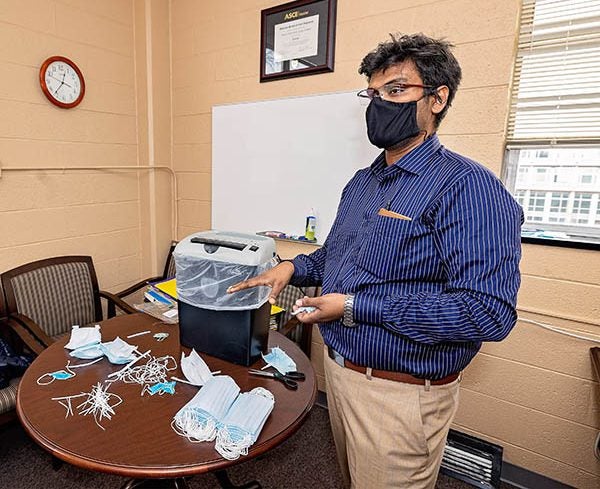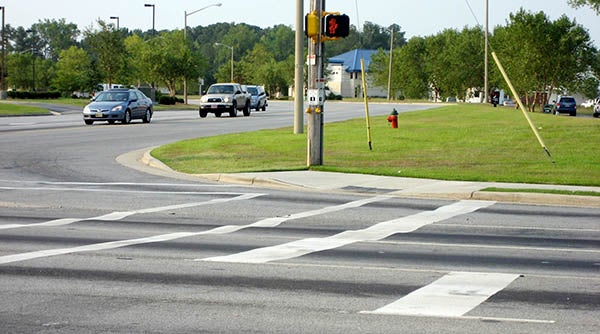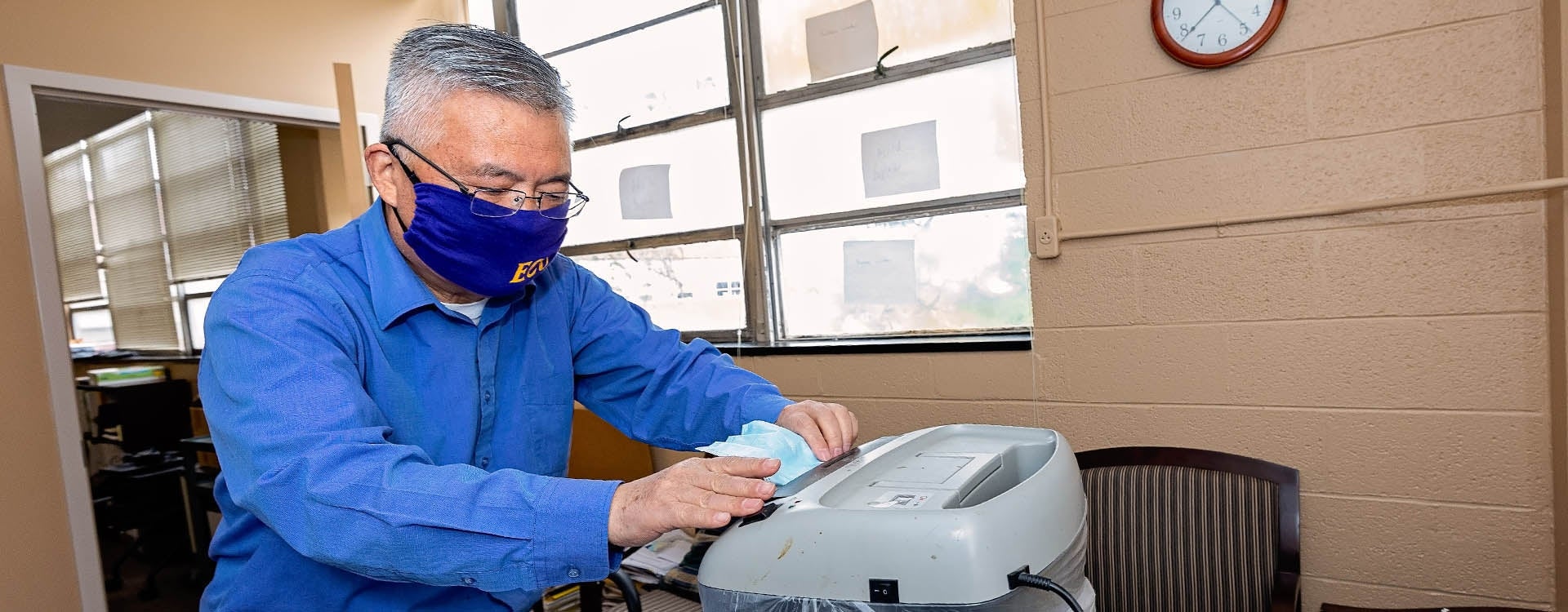TRASH TO TREASURE
ECU team publishes research on use of recycled masks in asphalt
While some may see trash, others see opportunity.
“You want to fully utilize any waste. It’s not waste. It can be a resource,” said Dr. George Wang, chair of East Carolina University’s Department of Construction Management.

ECU student Md. Hasibul Hasan Rahat talks about research looking at the use of recycled masks in asphalt last year. (Photo by Cliff Hollis)
When he saw a disposable medical mask used during the COVID-19 pandemic on a sidewalk, Wang wondered about how many such masks would soon end up in landfills, or worse yet, polluting the woods, rivers or oceans.
He led a research effort last year that explored the use of such masks as a binder to reinforce asphalt used to pave roads, and now the results of that research have been peer-reviewed and published in the journal Science of the Total Environment.
“I am very happy and satisfied that finally our research work got recognition,” said Md. Hasibul Hasan Rahat, a construction management graduate student at ECU who contributed to the research.
Wang said the masks that contain polypropylene could take more than a century to break down in landfills, and with billions of such masks produced and worn as the pandemic progressed, simply throwing them in the trash could create environmental issues.
The team of researchers determined that shredding the masks, heating them to liquid form and adding them to hot mix asphalt would act as a binding agent that would help roadways resist rutting — the permanent deformation of pavement that can occur as vehicles drive on the same areas on roadways over and over again. That rutting can create water ponding on the road that could contribute to vehicle crashes and can also cause deterioration of the pavement, leading to costly maintenance.
S.T. Wooten and the N.C. Department of Transportation (NCDOT) tested various mixtures with the recycled masks that showed a rut depth range of .9 to 3.2 millimeters, well below the maximum rut depth of 11.5 millimeters for local roads and 4.5 millimeters for interstate highway pavement.
Associate professor Dr. Carol Massarra, teaching assistant professor Dr. Jodi Farrington and teaching instructor Chelsea Buckhalter in ECU’s Department of Construction Management along with Jie Li from the Royal Melbourne Institute of Technology in Australia contributed to the research, as did Tony Collins from NCDOT and Jeffrey Johnson from S.T. Wooten.
However, just because the research was published doesn’t mean it’s finished.
“This is an excellent start for this important trend contributing to the field of how to use plastic,” Wang said. “It can’t be done based on just one research study. We’re just the start.”
Massarra said the next step is determining the feasibility of using recycled masks in asphalt.
“It’s great. We got a good result. The rutting of the asphalt was reduced, but is it cost effective?” Massarra said. “If we are going to do a section of the road, how many tons of masks do we need? There’s a lot that goes into it.”

Ruts like these on a road in Greenville can create driving hazards, especially in rain. (Contributed photo)
Rahat is exploring just that with a “cost calculator” as part of his thesis that he will present during ECU’s International Scholars’ and Students’ Symposium in April.
“It includes the cost of putting the bins out, collecting the masks, cost of transportation, labor and bringing the masks to the recycling facilities, sanitizing the masks and transporting them to the shredding company, and shredding the masks and then transporting them to the asphalt plant,” Massarra said. “The cost is high compared to not using masks, but we applied it to a small scale, just a sample, and we are going to investigate to see what would happen if we applied it on a larger scale such as an entire section of road. Our hypothesis is if we applied it on a larger scale, the cost may be less.”
Rahat said he was proud to be a part of the research team.
“This research and this publication are very significant in my academic career,” he said. “My dream is to pursue my Ph.D. in civil and construction engineering and start my professional career as an academician in the future. So, this research is the basement of my dream, as my research interest lies in recycling material and use of them as a substitute of construction material.”
The research led to an even broader look at the opportunities and challenges of plastic waste in the construction industry. Massarra, Wang and Rahat produced a paper that they will present as part of the Associated Schools of Construction International Conference April 20-23 in Atlanta.
“The material required to prepare the masks is polypropylene, which is basically plastic,” Rahat said. “We got the excellent results, so plastics could also be used as a substitute material in the future, since plastic production and pollution are growing rapidly.”
Wang said that just because the use of face masks may be declining as COVID-19 cases and mask requirements decrease doesn’t mean the research team’s efforts on reducing waste will end.
“The significance of this is that it just started with the face masks,” Wang said. “We know there’s much more plastic waste than face masks. That’s the direction we want to move this. We’re very happy to see fewer and fewer face masks in the nation and globally. That’s a good thing. However, plastic waste is becoming more and more severe, and that’s why the research is important.”
